Artículo
Migratory birds are sometimes known to make reverse movements to seek better fueling sites before undertaking long-distance migratory flights across ecological barriers. Red Knots (Calidris canutus rufa) regularly make prodigious migratory flights of ~ 8000 km from southern South America to North America; these flights depend critically on the birds being able to store adequate fuel at southern staging sites. Knots staging at San Antonio Oeste (SAO) in northern Patagonia in Argentina could potentially backtrack ~200 km southwards to complete refueling at Península Valdés (PV). We therefore analyzed resightings of birds individually marked in SAO or the flyway at these two staging sites in 2006, 2007, 2009 and 2010 to investigate whether reverse movements occurred between them. In the 4-year period, 63 detected individuals backtracked south from SAO to PV in one or more years; these movements occurred in all years of the study thus demonstrating the annual occurrence of flights of ~200 km in the opposite direction to the normal northward migration. There was no significant difference in body condition (mass), sex or day of first sighting in SAO between birds that made or did not make reverse movements to PV. However, individuals (N = 11) that backtracked to PV from SAO had significantly lower hematocrit levels at the time of capture than SAO resident birds (N = 205). Because migrating shorebirds have been shown to restore low hematocrit levels before undertaking rapid fuel storage to power long flights, we hypothesize that Red Knots backtracking to PV were likely behind schedule in migration, and thus may have traded-off the small cost of a ~200 km flight for the increased foraging time and high quality soft-shell prey available late in the season in PV. This hypothesis helps to explain the later staging phenology of Red Knots using PV, and its role as an alternative staging area in the northward migration. Las aves limícolas migratorias suelen realizar migraciones reversas con el fin de buscar mejores lugares de abastecimiento antes de realizar vuelos de larga distancia. Los correlimos gordos Calidris canutus rufa migran ∼ 8.000 km desde el sur de América del Sur hasta América del Norte. Estos vuelos dependen fundamentalmente de que las aves puedan almacenar la energía necesaria en los sitios de escala trófica. Por ello, las aves que realizan una escala en San Antonio Oeste (SAO), norte de la Patagonia, Argentina, podrían potencialmente realizar un vuelo reverso, es decir, en dirección opuesta a la normal dirección de migración hacia el norte, de ∼ 200 km hacia el sur para poder completar su alimentación en Península Valdés (PV). En este trabajo se presentan los registros de aves anilladas individualmente en ambos sitios durante las temporadas 2006, 2007, 2009 y 2010 con el fin de investigar si hubo aves que realizaron vuelos desde SAO hasta PV. En el periodo de estudio, 63 individuos realizaron un vuelo reverso desde SAO a PV en uno o varios años. No hubo diferencias significativas en la masa corporal, sexo y primer avistamiento en SAO, entre las aves que realizaron el vuelo reverso a PV y las que no. Algunos de ellos (N = 11) tenían niveles de hematocritos significativamente más bajos en el momento de ser capturados en SAO que las aves que no realizaron el vuelo reverso (N = 205). Las aves limícolas necesitan restaurar sus niveles de hematocrito antes de emprender un vuelo de larga distancia. Por ello, es probable que los correlimos gordos realicen un corto vuelo hasta PV para aprovechar las presas disponibles en este sitio hacia el final de la temporada de alimentación. Esta hipótesis podría explicar la fenología tardía de los correlimos gordos en PV, y su papel como área de escala alternativa en la migración hacia el norte.
Reverse movements of red knots Calidris Canutus during northward migration in Argentina
Título:
Vuelos reversos de correlimos gordos Calidris Canutus durante la migración al norte en Argentina
Fecha de publicación:
06/2014
Editorial:
Sociedad Española de Ornitologia
Revista:
Ardeola
ISSN:
0570-7358
Idioma:
Inglés
Tipo de recurso:
Artículo publicado
Clasificación temática:
Resumen
Palabras clave:
Patagonia
,
Peninsula Valdés
,
Reverse Movements
,
San Antonio Oeste
,
Shorebirds
Archivos asociados
Licencia
Identificadores
Colecciones
Articulos(CCT-CENPAT)
Articulos de CTRO.CIENTIFICO TECNOL.CONICET - CENPAT
Articulos de CTRO.CIENTIFICO TECNOL.CONICET - CENPAT
Citación
D'amico, Veronica Laura; Gonzalez, Patricia M.; Guy Morrison, R. I.; Baker, Allan J.; Reverse movements of red knots Calidris Canutus during northward migration in Argentina; Sociedad Española de Ornitologia; Ardeola; 61; 1; 6-2014; 63-76
Compartir
Altmétricas




